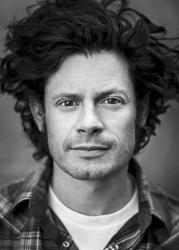Leonard Knight’s first message to the world—GOD IS LOVE—was supposed to be airborne, painted on the side of a hot-air balloon. The balloon itself was a minor miracle of persistence, scraps patched together over years. He even built a stove to inflate it, drove the whole contraption out to California’s Salton Sea, about an hour north of the Mexican border. The day was clear, good conditions. But the thing just wouldn’t lift.
Burdened by his failure, Knight prayed. God’s answer was to build a mountain.
Photographer Aaron Huey first met Knight in 2006, during a road trip from Los Angeles to Santa Fe. Knight was seventy-five, and still strong enough to carry a forty-pound bucket of adobe up a thirty-foot ladder, but too weak to carry the eighty-pound hay bales he’d been using to build Salvation Mountain for nearly thirty years. Huey lent a hand, and a dozen hay bales later he experienced his own epiphany. “I’d never met somebody who dedicated his entire life to making one thing. Leonard makes one thing. Leonard makes the mountain. Meeting him made me want to throw away all my things—my computer, my phone, my career, my ego—and help him build his mountain. Instead I moved a few hay bales and promised to come back.”
Since 2006, Huey has visited Salvation Mountain more than a dozen times, both to shoot and help with whatever he can—hauling adobe, or hay bales, tractor tires, telephone poles, and untold gallons of acrylic paint.
Since the beginning, Knight lived at the base of his calling, sleeping in the back of a broken-down fire truck covered in Scripture. He claimed no possessions, having trimmed his existence down to an ascetic, artistic purpose: wake, eat, build, bathe, sleep. Throughout the day he’d give tours to anyone who stopped to visit—to religious pilgrims, biker gangs, elementary schools, L.A. hipsters, and other wayward travelers. But for the most part he lived what Huey describes as “the simple life of a visionary. I have no doubt that what he’s done is the equivalent to sitting beneath the Bodhi Tree or in Muhammed’s cave,” Huey says. “He’s like an American sadhu. The mountain was his living daily meditation.”
“Maybe it’s a childlike faith that I’ve got,” Knight told him in 2009. “I just want to tell people ‘I love you, and let’s get a universal love down if we can do it.’ I don’t have much education, but I don’t have to have a master’s degree to love my God.”
Having chronicled such difficult subjects as the drug war in Afghanistan and the struggles of the Oglala Sioux Tribe in the US, Huey found that shooting Salvation Mountain was a surprising challenge, in its own way. “I knew it couldn’t be a traditional photojournalistic project,” he says, “because there’s only so much to document, there isn’t a broad range of emotion or subject matter. On another level, it’s too easy. It’s a giant, rainbow-covered mountain in the desert. You can’t really go wrong. But I tried to make images that transcended the postcard shots I usually see out there. I tried to really show the man and his process.” Meanwhile, over those dozen trips, Knight’s health deteriorated. And as his decline became more obvious, and the mountain itself seemed endangered, Huey began photographing with an almost microscopic intensity. “I’d shoot every inch of it,” he says, “sometimes with a 50mm lens, walking around, every piece of the surface.”
In the December 2011, Knight was admitted to the Veteran’s Care Center in El Cajon for dementia (he served in the Korean War); the years of living and working in the brutal extremes of California’s Colorado Desert had taken their toll. Since then, friends and pilgrims have kept watch over the mountain in an effort to protect and preserve it—from looters, and to touch up what the weather has eaten away. Despite the fact that Salvation Mountain is in the Congressional Record as a site “worthy of preservation,” its future is uncertain. Nevertheless, through a photographer’s calling, a testament survives, preserving the spirit of the man who built it.
“I think it’s something we all yearn for, the kind of focused simplicity in life that Leonard achieved. People who live like that are generally labeled as crazy, and certainly many people would call Leonard that. But I saw a visionary, I saw the kind of focus that most people will never find, and a life of non-attachment most of us could never imagine.”




















